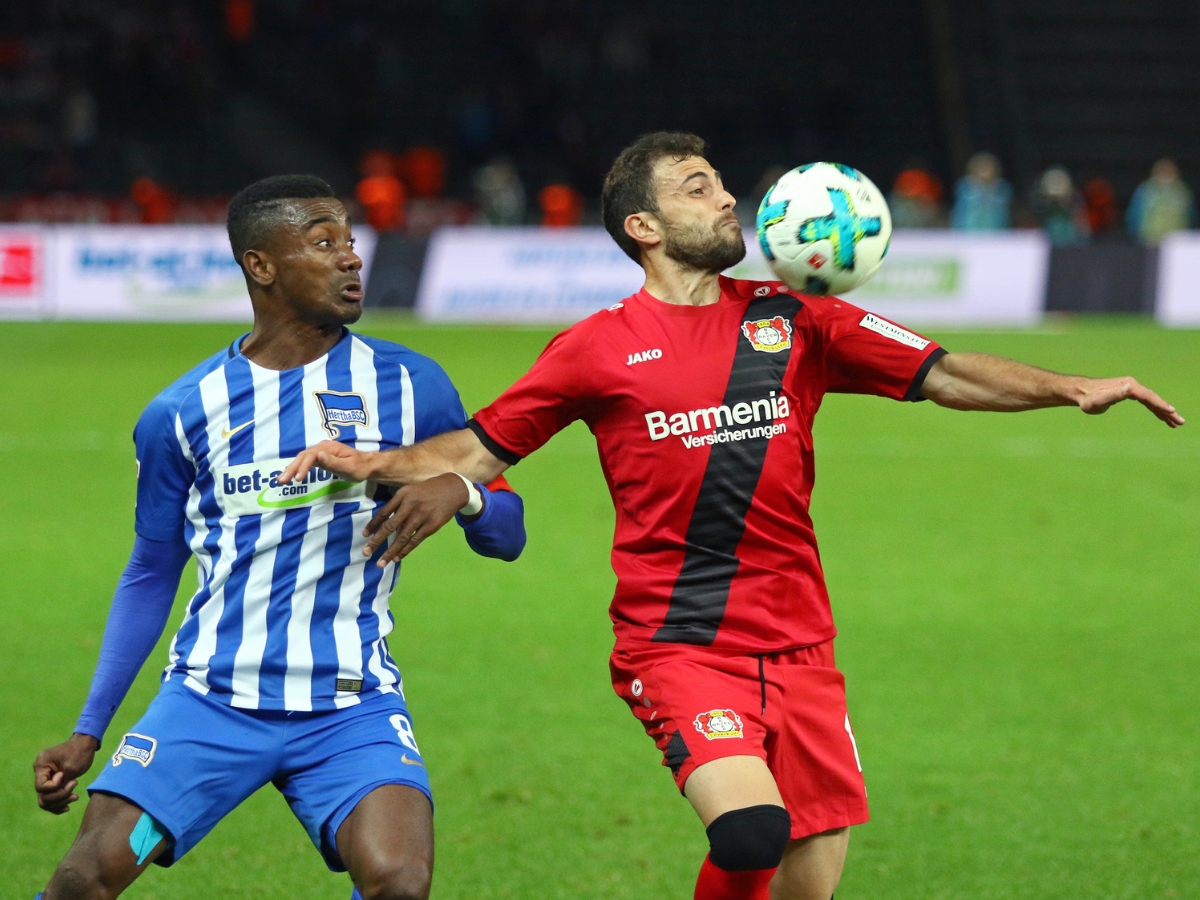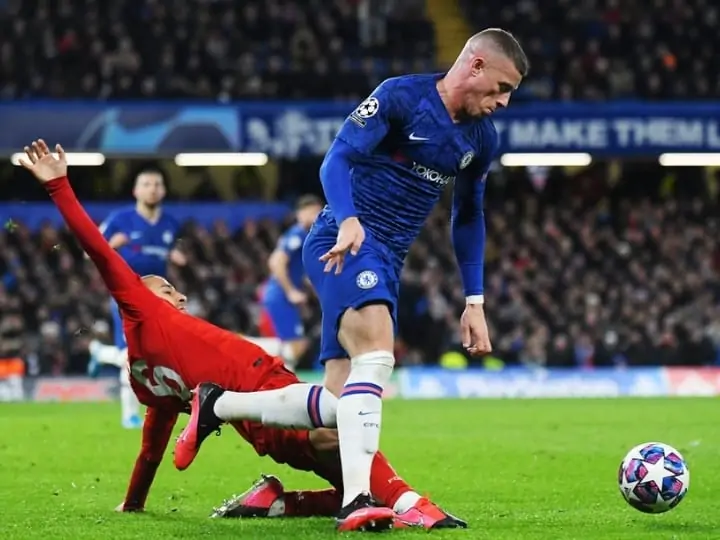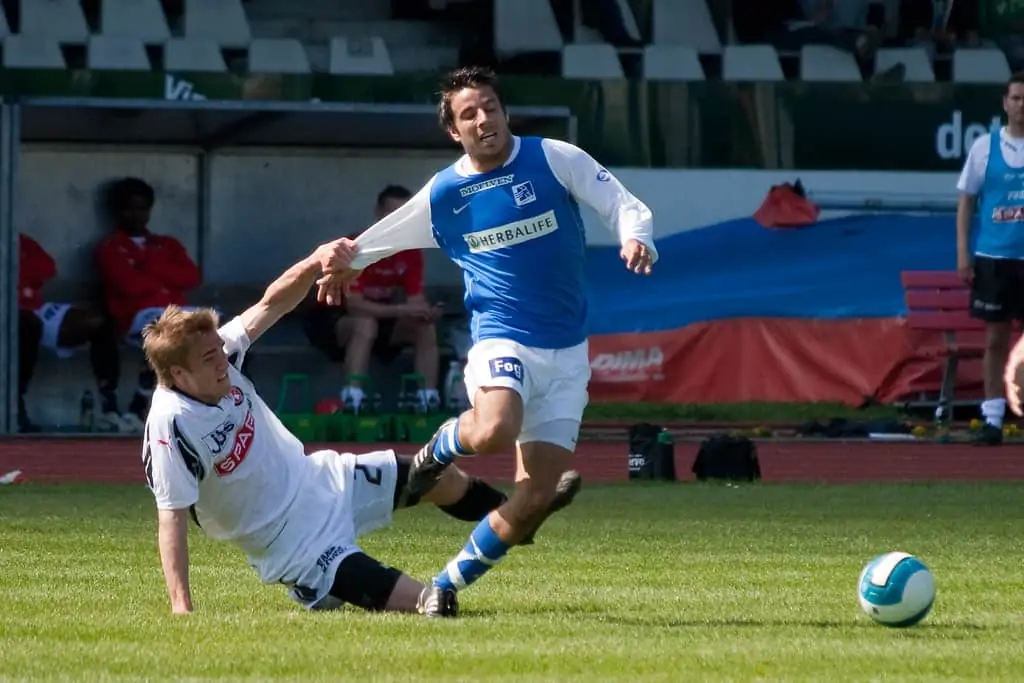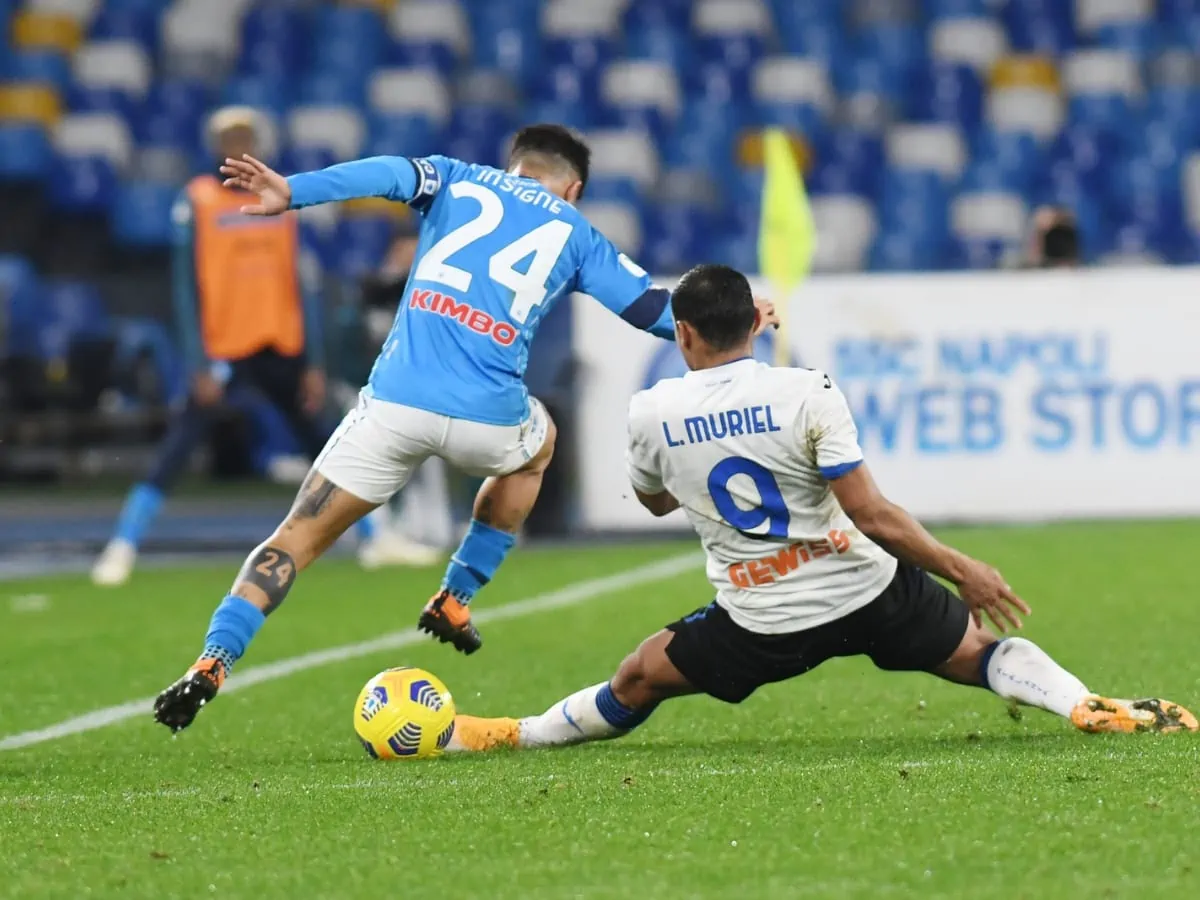Share the post "Is Soccer A Contact Sport? (Unwritten Rules)"
Soccer is known as “the beautiful game” for a reason. It is a skill-based sport that isn’t known for its hard hits or high-speed collisions. Despite this, physicality has a role to play. This begs the question, is soccer a contact sport?
In this article, we’ll discuss physical contact in soccer and whether it is a contact sport, what’s allowed, what’s not, and more.
The main topics covered are:
- Is soccer a contact sport?
- How much contact is allowed in soccer?
- How to shoulder tackle legally
- What is a contact sport?
Before we get started, do you think soccer should be considered a contact sport?

Is Soccer a Contact Sport?
Soccer is a contact sport that involves a combination of light to medium, and occasionally heavy impacts.
While tackling with excessive force, charging, and striking opponents are illegal in soccer, players often overstep the boundaries.
Although this generally results in appropriate sanctions being awarded, it doesn’t prevent significant contact from occurring.
Is Soccer a High Contact Sport?
When compared to other global sports like American football, rugby, and Australian rules football, or combat sports like boxing and mixed martial arts (MMA), soccer isn’t a high contact sport.
This is because the main aspects of these sports involve heavy blows.
The primary goal in the sport of boxing is to hit your opponent. As physically punching each other is the main focus, boxing is regarded as a high contact sport.
In American football, blocking and tackling are some of the most essential skills, meaning it also falls into the category of high contact.
In soccer, teams can theoretically score a goal or defend an attack without making contact with other players.
Although most possessions involve physical contact through tackling, shielding, or jostling, several minutes can go by in a game without any major contact between players.
Such phases of play, as well as the tendency of modern players to feign injury, lead many people to believe that soccer is a non-contact sport. Despite the reduction in physicality over the years, there is still a lot of contact in the sport.

Contact In Soccer
A common misconception about soccer is that physical contact is against the rules. People assume that while incidental contact might be part and parcel of the sport, it is technically not allowed.
However, the rules of soccer permit plenty of contact. Earlier, we mentioned that heavy fouls and excessive contact are illegal but unavoidable and that this automatically makes it a contact sport.
Although this is true, soccer is also regarded as a contact sport in terms of what you’re allowed to do.
While the main emphasis in soccer is to outplay your opponents with skill, speed, tactics, and teamwork, physicality has an important role to play.
Players are allowed to make contact with each other when tackling, dribbling, and competing for a loose ball. The contact mustn’t be excessive, however, and the intention should be to win the ball, rather than knocking over or hurting the opposing player.
The referee is responsible for judging whether or not contact is excessive.
Professional soccer teams can make an average of over 20 tackles per game, clearly demonstrating that there is significant contact in the sport.

What Is Illegal Contact In Soccer?
The International Football Association Board (IFAB) is the organization responsible for governing the laws of the game of soccer.
Under Law 12: Fouls and Misconduct, IFAB outlines what contact is punishable as well as the recommended penalties.
What The Rules Say: Is Contact Allowed In Soccer?
According to the official laws of the game, referees should award a direct free kick if a player takes the following actions in a careless or reckless way, or with excessive force:
- Charges at an opposing team member
- Jumps at an opposing team member
- Kicks or attempts to kick at an opposing team member
- Pushes an opposing team member
- Strikes or attempts to strike (e.g. punch, kick, slap, scratch, choke, or headbutt) an opposing team member
- Tackles an opposing player
- Trips or attempts to trip an opposing player
- Holds onto an opposing player or pulls their jersey
- Impedes the progress of an opposing player with contact
To help clarify the rules, IFAB defines careless, reckless, and excessive force:
- A player acts carelessly by showing a lack of consideration or attention to their opponent when tackling or challenging them.
- A player is deemed as acting recklessly when they tackle or challenge an opponent with no regard for their safety or the consequences of their actions.
- Excessive force is when players go beyond the necessary amount of force for a tackle or put an opponent’s safety in jeopardy with a challenge. Excessive force is typically punished with a red card.

Can You Use Your Hands In Soccer?
Soccer is played predominantly with the feet. Players generally use their feet, knees, thighs, chest, and head to control the ball, shoot, and pass. Outfield players are prohibited from using their hands or arms (up to the armpit) to touch the ball.
The only players allowed to handle the ball are the goalkeepers, and they are restricted to doing so within their penalty box.
However, the hands and arms can be used for other aspects of the game. For example, throw-ins are used to reintroduce the ball to the field after it is knocked out over the sideline.
Hands can also be used to tussle and challenge for the ball. Your hands and arms play an important role in shielding the ball from an opponent.
Players are allowed to hold off their challengers using their arms, leaning their body into opponents, and keeping them away from the ball. Pushing an opponent with the arm from this position is a foul.
Eden Hazard is one of the best current players at using his body to shield the ball and win fouls.
Get your very own Eden Hazard Real Madrid jersey here.
As you can imagine, elbowing an opponent is illegal. Players must avoid flailing their arms in case they make contact with an opponent. Even an accidental elbow often results in a red card as it can cause a serious injury.
With the prominence of VAR in today’s game, players have to be extra careful regarding the use of their hands. Whether a player uses their arms to gain extra elevation when competing for a header or when scrambling to keep up with the opponent they’re marking, every movement is picked up by VAR.
Whatever way you try to gain an advantage, remember that the contact can’t be careless, reckless, or with excessive force.
Can You Body Someone In Soccer?
One of the most popular soccer-related queries online is whether you “can body someone in soccer?”
If you’re unfamiliar with pop culture, this essentially means to beat someone up. In soccer terms, this could be interpreted as charging someone aggressively or knocking them over.
As we discussed earlier with the IFAB rules, the most important factor in deciding the legality of tackles is whether the challenge was careless, reckless, or committed with excessive force.
In most cases, body checking or slamming into an opponent is illegal and will result in a foul being called against the offending player.
When it comes to major physical contact in soccer, the most aggressive legal contact occurs when players challenge each other shoulder-to-shoulder.

Can You Shoulder Someone in Soccer?
Shoulder-to-shoulder contact is generally allowed in soccer. It is one of the best ways a player can use their size, strength, and physicality effectively.
Shoulder tackling is essentially when you challenge a player from the side, initiating contact between your shoulder and your opponent’s.
It is a common occurrence on the soccer field, particularly between midfielders competing for 50-50s.
For many center backs, using shoulder-to-shoulder tackles is an important equalizer that enables them to compete with fast and skillful strikers. Effective shoulder tacklers, ease their opponents out of the way, winning the ball fairly.
However, the art of the shoulder tackle isn’t as easy as you might think. Extending your elbow, colliding with a player’s back, going too low, or shouldering with excessive force will be called a foul.
Mistiming a shoulder tackle can cause you to fall over embarrassingly! Players can easily evade your challenges if you’re constantly charging aggressively into tackles, causing you to lose your balance.
Overcommitting to tackles in soccer is known as “diving in” and it should be avoided. One of the worst defensive habits you can develop is diving in.
Whether you’re too aggressive or not aggressive enough, failing to learn how to shoulder tackle fairly can be costly to you and your team.
Shoulder Contact Tips
When you’re called upon, you must have the skillset to dispossess your opponent fairly. Let’s take a look at some top tips for perfecting shoulder-to-shoulder contact.
- Stay in control at all times and don’t let momentum get the better of you
- Keep your elbows tucked in
- Lower your center of gravity but make sure to stay in line with your opponent’s shoulder
- Align your hips with your shoulders to maintain balance as you make contact
- Avoid leaning into the player as you may commit a foul or fall over
- Once you initiate contact, make an effort to win possession of the ball, demonstrating intent to make a legal tackle
While size, strength, and weight can give you a significant advantage when shoulder tackling, they don’t automatically make you a better defender. Timing, balance, a low center of gravity, and core strength are far more important.
Take N’Golo Kante for example, the Chelsea star and World Cup-winning French midfielder stands a mere 5’ 6” and weighs approximately 154 lbs, yet he regularly dominates opponents physically.
Here is Kante, demonstrating the perfect shoulder tackle technique.
As the legendary World Cup-winning Italy captain, Fabio Cannavaro said:
“As a defender, you can be many shapes and sizes. You can be short and fast. Or you can be tall and jump high. It doesn’t matter.”
Fabio Cannavaro
What Is Considered a Contact Sport?
Quite simply, a contact sport involves physical contact between competitors. Contact may not be legal in team sports, but it is often unavoidable. That’s why it’s important to distinguish between levels of contact sport.
Some sports require physical contact and cannot exist without it. Rugby, wrestling, Brazilian jiu-jitsu, and other forms of martial arts cannot be played without contact. Sports that are heavily reliant on contact are often referred to as high-contact.
Semi-contact and limited-contact are common terms used to describe sports where some contact is legal but with restrictions.
Taekwondo is an example of a semi-contact sport. While striking the opponent with punches and kicks is the main objective, competitors must limit the power of their strikes.
Basketball is an example of a limited-contact sport. While some contact is inevitable and part of the game, players are prohibited from being overly physical.
Dispossessing opponents is a skill that must be done cleanly, without touching the opponent’s hands. Soccer divides opinions on whether or not it is a full-contact or limited-contact sport.
When you consider some of the legendary physical contests down the years, as recently as “The Battle of Nuremberg” in the 2006 World Cup, it’s hard to deny the physicality of soccer.
List of Contact Sports
Some of the most popular contact sports in the world are:
Full Contact
- American football
- Rugby
- Ice Hockey
- Australian rules football
- Water polo
- Boxing
- Mixed martial arts (MMA)
- Wrestling
- Kickboxing
- Brazilian jiu-jitsu
- Judo
Limited Contact
- Baseball
- Basketball
- Handball
- Squash
- Lacrosse
- Netball
You can also consider sports with incidental touching as contact sports, even though they are technically non-contact. Examples of these sports include motocross, Moto GP, BMX, road cycling, and various types of motorsport.
What Sports Are Non-Contact?
Non-contact sports are those that don’t require physical contact between competitors. Popular non-contact sports include:
- Tennis
- Table tennis
- Bowling
- Golf
- Badminton
- Snooker
- Rowing
- Gymnastics
- Olympic diving
- Some track and field disciplines
Share the post "Is Soccer A Contact Sport? (Unwritten Rules)"
Joel is a seasoned soccer journalist and analyst with many years of experience in the field. Joel specializes in game analysis, player profiles, transfer news, and has a keen eye for the tactical nuances of the game. He played at various levels in the game and coached teams - he is happy to share his insight with you.



